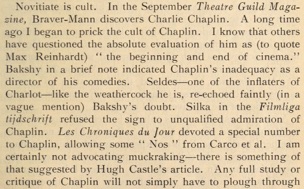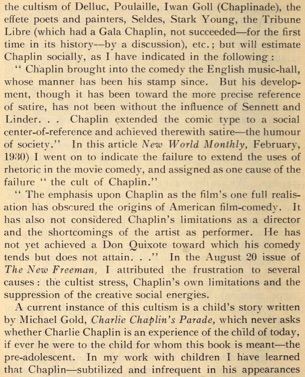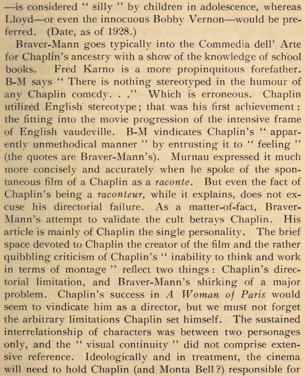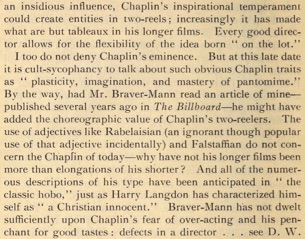The Circus 1927 1928 1929 next previous
The Circus Clippings 375/376
Harry Alan Potamkin, Close Up, Territet, Switzerland, Nov. 1930
„The fatuous and dissociated pity of The Circus“
Editorial content. „FILM NOVITIATES, ETC.“ (...)
„Novitiate is cult. In the September Theatre Guild Magazine,
Braver-Mann discovers Charlie Chaplin. A long time ago
I began to prick the cult of Chaplin. I know that others have
questioned the absolute evaluation of him as (to quote
Max Reinhardt) ,the beginning and end of the cinema.‘ Bakshy
in a brief not indicated Chaplin‘s inadequacy as a director
of his comedies. Seldes – one of the inflaters of Charlot – like
the weathercock he is, re-echoed faintly (in a vague
mention) Bakshy‘s doubt. Silka in the Filmliga tijdschrift refused
the sign to unqualified admiration of Chaplin. Les
Chroniques du Jour devoted a special number to Chaplin,
allowing some ,Nos‘ from Carco et al. I am certainly
not advocating muckraking – there is something of that
suggested by Hugh Castle‘s article. Any full study
or critique of Chaplin will not simply have to plough through
the cultism of Delluc, Poulaille, Iwan Goll (Chaplinade),
the effete poets and painters, Seldes, Stark Young, the Tribune
Libre (which had a Gala Chaplin, not succeeded – for
the first time in its history – by a discussion) etc.; but will
estimate Chaplin socially, as I have indicated in the
following:
,Chaplin brought into the comedy the English music-hall,
whose manner has been his stamp since. But his
development, though it has been toward the more precise
reference of satire, has not been without the influence
of Sennett and Linder... Chaplin extended the comic type
to a social center-of-reference and achieved therewith
satire – the humour of society.‘ In this article New World Monthly,
February, 1930) I went on to indicate the failure to extend
the uses pf rhetoric in the movie comedy, and assigned as one
cause of the failure ,the cult of Chaplin.‘
,The emphasis upon Chaplin as the film‘s one full
realisation has obscured the origins of American
film-comedy. It has also not considered Chaplin‘s limitations
as a director and the shortcomings of the artist
as performer. He has not yet achieved a Don Quixote toward
which his comedy tends but does not attain...‘ In the
August 20 issue of The New Freeman, I attributed the frustration
to several causes: the cultist stress, Chaplin‘s own
limitations and the suppression of the creative social energies.
A current instance of this cultism is a child‘s story
written by Michael Gold, Charlie Chaplin‘s Parade, which never
asks whether Charlie Chaplin is an experience of the
child of today, if ever he were to the child for whom this book
is meant – the pre-adolescent. In ma work with children
I have learned that Chaplin – subtilized and infrequent in his
appearances – is considered ,silly‘ by children in
adolescence, whereas Lloyd – or even Bobby Vernon –
would be preferred. (Date, as of 1928.)
Braver-Mann goes typically into the Commedia dell‘ Arte
for Chaplin‘s ancestry with a show of the knowledge
of school books. Fred Karno is a more propinquitous forefather.
B-M says ,There is nothing stereotyped in the humour of
any Chaplin comedy...‘ Which is erroneous.“ (...)
„I do not deny Chaplin‘s eminence. But at this late date
it is cult-sycophancy to talk about such obvious Chaplin
traits as ,plasticity, imagination, and mastery of pantomime,‘
By the way, had Mr. Braver-Mann read an article
of mine – published several years ago in The Billboard –
he might have added the choreographic value of
Chaplin‘s two-reelers.“ (...) „No Chaplin film beyond two reels
can compare a structure-in-comedy with Hands Up!
No Chaplin film can equal in the enactment of the comic
spirit such a work as Mark Twain‘s A Connecticut
Yankee in King Arthur‘s Court. And Chaplin promised to give
us a film of social quixoticism, where his pathos would
render the humor poignant as a social indictment. He gave
us The Circus, in which the pathos seeped out until
it trailed after the conclusion of the film.“ (...)
„Certainly Stark Young was wrong in seeing Chaplin
as too much theatre – Charlie re-converted his
derivation – but that the latter has not extended his tendency
far enough along the path toward fulfilment, was sadly
perceivable in the fatuous and dissociated pity of The Circus,
and in the foreshortened exposure of The Pilgrim.
Harry Alan Potamkin.“
Redaktioneller Inhalt
The Circus 1927 1928 1929 next previous





